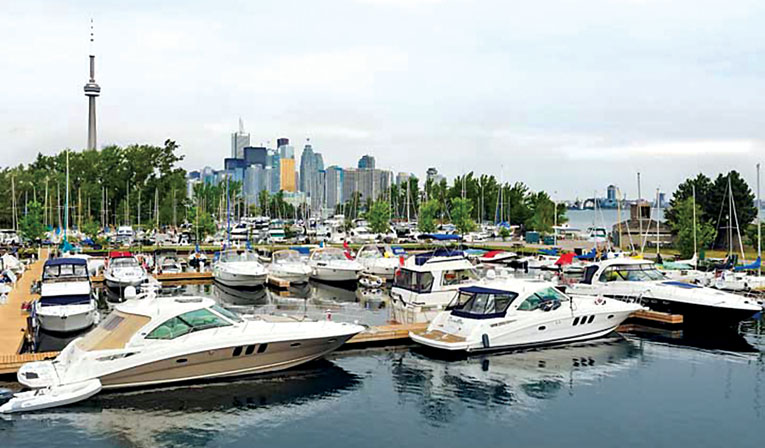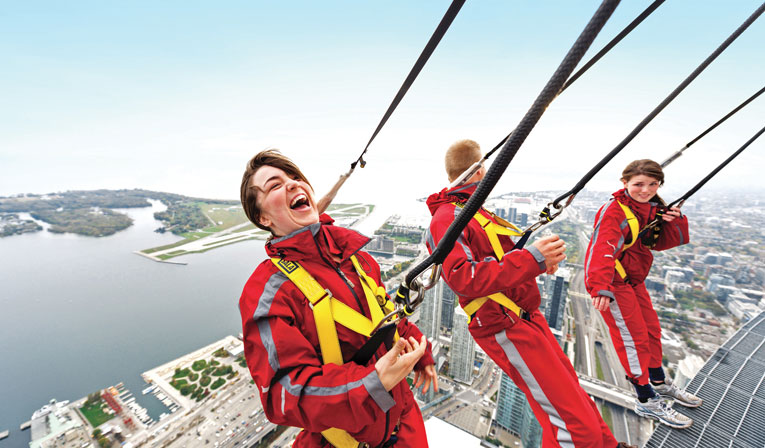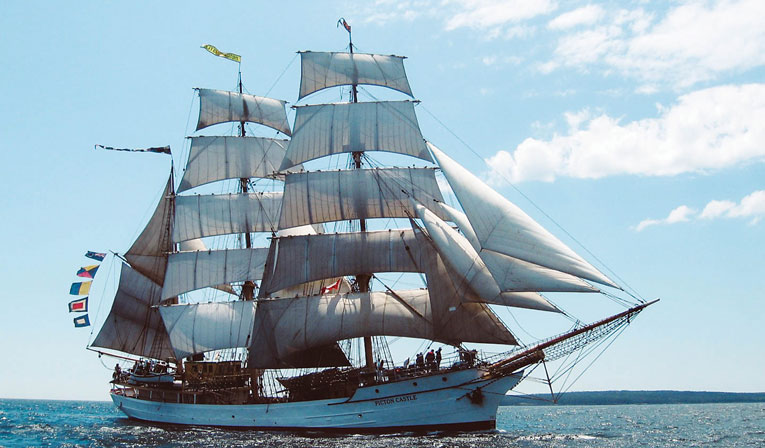Photo Courtesy of Ontario Tourism
A multi-faceted personality has blessed Toronto, Ontario, with an abundance of colorful nicknames. But all it takes is a single visit to leave boaters calling it their own slice of waterfront heaven.
Hogtown. The Six. Hollywood North. YYZ. Toronto has always been a city known for its nicknames, each of which reflects a different side of Canada’s largest metropolitan area. Hogtown is a nod to Toronto’s agricultural past, when its stockyards shipped maple-smoked bacon to markets all over the world. The Six refers to the last digit in its original 416 area code, distinguishing the city proper from its 905 suburbs. Hollywood North reflects Toronto’s current role as a major center for television and movie production, while YYZ refers to its airport code, with an appreciative nod to a popular song of the same name by native sons, Rush. But none of these monikers, on their own, can even begin to capture the full essence of one of the world’s most unique cities.
With a population of 2.8 million people in the city proper and more than six million living in its greater metropolitan area, Toronto is the largest city in Canada and the fourth largest in North America, surpassed by only Mexico City, New York and Los Angeles. It’s also among the most ethnically diverse cities in the world, a place where you’ll hear more than 130 different languages spoken and where more than half the population was born in another country. People come to Toronto in pursuit of the Canadian Dream, and it’s this incredible diversity and richness that makes Toronto the Good (yet another nickname, recognizing its cleanliness and low crime rate) one of the most rewarding travel destinations in the world.
It’s an easy place to find, especially if you’re arriving the old-fashioned way, by boat.
Situated on the north shore of Lake Ontario a little less than 30 miles from its western end, and almost directly north of the Niagara River, Toronto is easy to spot from the water; just look for the 1,808-foot-tall CN Tower, which is visible from at least 50 miles away in clear weather, day or night. Completed in 1976, the CN Tower was the tallest free-standing structure in the world for 32 years, until it was eclipsed in 2008 by the Canton Tower in China. Although no longer the world’s tallest, the CN Tower remains an unmistakable landmark welcoming boaters to Toronto’s waterfront.
As you approach more closely, the downtown skyscrapers become clear, particularly the gleaming gold towers of the Royal Bank Plaza, the brick red spire of the Scotiabank Tower, and the massive white dome roof of the Rogers Centre baseball stadium. The harbor itself is protected by two prominent land formations, including a large, naturally formed series of islands directly offshore from the downtown core, and the Leslie Street Spit, a man-made finger of land that extends from the eastern shore almost to the Islands. To enter Toronto Harbour you need to bypass these features and navigate through one of two dredged channels known as the Eastern and Western gaps, located at either end of the Islands.
If you’re planning to navigate within Toronto Harbour, you’ll need a Power Vessel Operator’s Permit, issued by the Toronto Port Authority (call 416-778-1230 or download an application online at torontoport.com). The cost is $20 and it’s valid for 14 consecutive days.
The Eastern Gap
The Eastern Gap is the primary entrance to Toronto Harbour. Watch for two flashing red lights marking the end of the Leslie Street Spit. From there, flashing red and green channel buoys are located just to the west of these beacons, marking the entrance to the harbor channel. The water here is deep and free of obstructions, but it’s always a good idea to keep an eye out for large lake freighters navigating through this confined space. If you see one, get out of the way and give the big boat plenty of room.
The Western Gap
Visiting boaters should also be cautious if they choose to enter the harbor through the shallower Western Gap, which separates the shoreline from the Billy Bishop airport on Toronto Island. White and orange buoys with flashing yellow lights mark restricted areas off the ends of the airport runways both outside and inside the harbor; you’ll need to stay well outside of these markers at all times. You’ll also need to watch for boat traffic motoring through openings in the shoreline breakwater just west of the gap, as they pass to and from some local yacht clubs. Ferry traffic running between the shoreline and the island airport represents yet another potential hazard to watch out for, while the shallow water and bottom topography in the immediate area can result in a rough ride when navigating this passage in a strong south or west wind.
Regardless of how you arrive, the Inner Harbour is usually a very busy place dotted with all manner of small craft and Toronto’s iconic white-and-black ferries, as they shuttle back and forth between the shoreline and the islands. The speed limit in the harbor is 10 knots, reduced to five knots within 500 feet of shore.

Photo Courtesy of Toronta Island Marina
QUIET RETREATS
 While the hustle and bustle of the downtown core is addictive, Toronto also has its quiet side. For those who prefer a slower pace at the end of the day, excellent marina facilities just outside of downtown offer a quiet alternative to staying among the skyscrapers, while excellent rapid transit connections still allow easy access to all the fun.
While the hustle and bustle of the downtown core is addictive, Toronto also has its quiet side. For those who prefer a slower pace at the end of the day, excellent marina facilities just outside of downtown offer a quiet alternative to staying among the skyscrapers, while excellent rapid transit connections still allow easy access to all the fun.
Visiting boaters in search of a more peaceful place to tie up often gravitate toward Humber Bay, which sits about one mile west of Toronto’s Western Gap. Look for two large brown condominium buildings that stand alone on the shoreline marking the mouth of the Humber River. Both structures have red aircraft obstruction lights on their roofs, so they’re easy to spot even after dark. About a mile up the shallow Humber River is The Humber Yacht Club. Just west of the condos is Humber Bay Park and its large yacht basin, home to the Etobicoke Yacht Club and the Mimico Cruising Club.
East of downtown, Ashbridges Bay Park, a little over two miles from the Eastern Gap, offers full facilities for visiting boaters in a beautiful location that borders Toronto’s trendy Beaches district. Just follow the Leslie Street Spit shore and you’ll find Ashbridges Bay tucked in among a stand of stately willow trees. Once you’re tied up, follow a neatly manicured wooden boardwalk that extends east along the shoreline and you’ll soon find yourself in the thick of one of Toronto’s most vibrant and picturesque neighborhoods. Known for its welcoming restaurant patios and eclectic shopping, the Beaches is a real treat at any time of year.
Photo Courtesy of toronto.ca
Photo Courtesy of centreisllandmarina.ca
The Toronto Islands
Protecting the Inner Harbour from Lake Ontario storms, the Toronto Islands are a favorite destination for Torontonians seeking an escape from the city. The only islands in western Lake Ontario, the Toronto Islands are home to several yacht clubs, the Centreville Amusement Park and a nude beach at Hanlan’s Point on the western end of the archipelago.
For visiting boaters, the islands rank among the best places to stay when you visit, with their peaceful surroundings and stunning views of the city skyline. The Island Yacht Club, Toronto Island Marina, Harbour City Yacht Club, Royal Canadian Yacht Club and Queen City Yacht Club all accommodate transient boaters. Day trips to the city are easy enough; grab a ride on a water taxi or yacht club shuttle, or do the trip in style on one of the Toronto Island ferries. Running continuously since 1833, the ferry service operates six vessels on four routes, serving Ward’s Island, Centre Island, Hanlan’s Point and the Billy Bishop Airport. The first three routes dock on shore at the Jack Layton Terminal at the foot of Bay Street, within easy walking distance to the subway and most downtown attractions.
Best known for their quiet lagoons along the north side and the sandy beaches along their southern perimeter, the islands are home to the Centreville amusement park, built in 1967 with a turn-of-the-century theme. There are paved roads on the islands, but no vehicular traffic apart from emergency and service vehicles. The standard way to get around is to walk or bike. At the eastern end of the island chain, Ward’s Island and Algonquin Island are home to roughly 300 year-round residences — the homes of extremely lucky Torontonians with arguably the most scenic commute of all. There are also two daycare centers, a school and a church.
Here’s a fun tidbit of Toronto Island trivia: Back in 1914, baseball legend Babe Ruth hit his first home run as a professional player on the Toronto Islands while playing in a game at the former Hanlan’s Point Stadium. The ball, they say, has never been found.
Harbourfront
Much of the Toronto shoreline facing the islands is built on reclaimed industrial land that has been developed into delightful parkland, restaurants, shopping complexes and luxury condominiums. Called Harbourfront, this area is well known for its lively music scene, with frequent outdoor concerts held throughout the summer, as well as live theater performances and visual arts displays.
Most of the action takes place west of Yonge street around the 2,000-seat Westjet concert stage — a distinctive, high-peaked, open-sided steel-and-glass venue that overlooks the water. Nearby, the Power Plant — a former power generating station turned art gallery — presents regular shows of classic and contemporary works by both established and emerging artists. A broad and inviting boardwalk that runs along the water’s edge here invites visiting boaters to stretch their legs and take in the sights for a considerable distance in either direction. The boardwalk connects to the much longer Waterfront Trail, allowing walkers and runners to potentially circumnavigate Lake Ontario either on foot or by bicycle.
Harbourfront is home to many of Toronto’s most popular bars and restaurants, and the view is a big reason why. It’s always buzzing with activity, particularly during the summer when it seems like there’s a different festival or special event every week.
Mooring options for visiting boaters run right across the waterfront. Along the shoreline, Marina Quay West, just inside the Western Gap, welcomes transient boats up to about 60 feet in length. Larger vessels up to 200 feet can usually find a spot at nearby Harbourfront Center. Marina Four, still farther east, accommodates vessels up to about 40 feet.
Additional mooring options can be found along the shoreline just outside of the Western Gap, including the National Yacht Club and the Alexandra Yacht Club, which accommodate vessels to about 40 feet. Although a little farther from the main attractions, these locations tend to be a lot quieter, especially on summer weekends.
Outer Harbour Marina, located on a finger of land extending from the eastern shoreline, is a large, full-service facility capable of handling yachts to 100 feet. Although it’s only a short 10-minute Uber ride to downtown, this location offers a quieter option for those who don’t want to stay right in the thick of the action.
Hello, neighbors
While the waterfront and islands offer myriad charms, you can’t really say you’ve visited Toronto without exploring some of its fabled neighborhoods. Thankfully, this is incredibly easy to do as Toronto is blessed with an outstanding public transit system operated by the Toronto Transit Commission, or TTC. Many locals simply call it the Red Rocket in reference to the bright red paint gracing the city’s transit vehicles. The TTC is a clean, safe and efficient network of subways, buses and streetcars that crisscross the entire metropolitan area with frequent service, making it fast and easy to explore even the most distant parts of the city.
Some Toronto neighborhoods are known for their history and architecture. Cabbagetown, with its impressive collection of Victorian structures and architecturally significant homes, remains as impressive today as it was when it was built back in the Georgian period. The industrial, red brick Distillery District was once the largest whisky-producing region in the world. Carefully refurbished, it’s now home to a charming combination of art galleries, shops, restaurants and performance venues.
Old Town Toronto, just steps from the waterfront, boasts a number of historically significant buildings from Toronto’s past, including the lively St. Lawrence Market, where shoppers haggle with vendors over the price of cheese, meats, fish, poultry and produce to this day. The nearby Gooderham Flatiron Building is a Toronto icon that exhibits a combination of the modern Gothic Revival and Romanesque Revival styles. Just down the street lies another iconic jewel in Toronto’s skyline, the Fairmont Royal York Hotel, which was the largest structure in the entire British Empire when it opened in 1929.
Other Toronto neighborhoods are known for their vibrant culture. Greektown, Chinatown, Little Italy, Little Portugal, College Street and Queen West each offer their own distinct charms, reflecting Toronto’s multinational makeup.

Photo Courtesy of Tourism Toronto
A shopping Mecca
If you like to shop, you’re going to love it here. From today’s trendiest fashions to haute couture, Toronto literally offers something for everyone.
The Eaton Centre, on Yonge Street between Queen and Dundas streets, is a multi-level indoor mall with an international reputation for its spectacular shops. Named after the now-defunct Eaton’s department store that once anchored it, the Toronto Eaton Centre attracts more visitors each year — in excess of 50 million — than any other attraction in the city. In fact, it ranks as the busiest shopping mall in the world thanks to its excellent transit access, its downtown location and high tourist traffic.
If your tastes run more to Dior, Versace and Louis Vuitton, then hop on the Rocket for a short trip up to Yorkville. Located north of Bloor Street and west of Yonge, this fashionable district is where you’ll find global luxury brands and designer duds from all of the top designer labels.
For those with more eclectic tastes, Queen Street West between University and Bathurst streets offers an interesting array of second-hand clothing shops, home decor stores, cafés, bars and restaurants. It’s also a great spot for live music in the evenings and among the top people-watching spots in the city.
For book worms, the Nautical Mind bookstore has been a staple in the Toronto harbor since 1980 and is a quick stroll from Marina Quay West and Marina Four. The independent bookstore carries a comprehensive selection of marine books, charts and cruising guides for all types of boaters.
Festivals galore
Perhaps the greatest thing about visiting Toronto is that there’s always something going on. When it comes to summer festivals, T.O. (still another nickname, short for Toronto, Ontario) has few rivals.
Visit in late June and you’ll be just in time for the Wine and Spirit Festival, where wine samples, craft beers and food pairings are the order of the day. Held on Sugar Beach, it thoughtfully overlaps with the Craft Beer Festival at the exhibition grounds, where local artisan brewers show off their best.
Originally a small affair created to promote gay rights, the Toronto Pride Parade has become a city-wide celebration of inclusiveness and respect. The parade — which caps off the annual Pride Week celebration each June — attracts crowds in excess of 100,000 people every year.
Toronto’s annual Ribfest brings out crowds of carnivores to Centennial Park over the Canada Day weekend at the beginning of July, while the Beaches Jazz Festival, held during the month of July, attracts big-name jazz artists and jazz aficionados from all over the world. Caribana, held in early August, celebrates all things Caribbean, while Taste of the Danforth, which follows a week later, honors Toronto’s Greek community. Although the Canadian National Exhibition, held on the waterfront at the end of August, is seen by many as the official end of summer, the celebrations continue into the fall with the Toronto International Film Festival in early September, the Toronto Ukrainian Festival in mid-month and the Toronto Garlic Festival, celebrating — you guessed it — everything to do with garlic.
The great indoors
For all of its energy and outdoor activities, Toronto is also a place to enjoy the great indoors and embrace the finer things in life.
One of the world’s great cities for live performance art, Toronto is home to a vibrant theater scene that ranks third in the world behind New York and London in its scope and the quality of performances. Beautiful historic venues, like the Royal Alexandra Theatre and the Princess of Wales Theatre, along with contemporary stages, like the Ford Centre for the Performing Arts, the Young Centre and a host of smaller venues, present a wide range of plays, musicals and improv productions featuring big-name stars. Getting tickets to the major shows can be tough, so shop online before you visit to ensure you score the best seats. Or, give one of the smaller theaters a try and enjoy a show that’s often just as enjoyable and far more intimate.
If your tastes run more toward live music, you’ll enjoy Toronto’s packed concert agenda, with a wide variety of venues offering everything from opera to heavy metal every night of the week. Pick up a copy of the free NOW newspaper — widely available downtown — or prowl its website (nowtoronto.com) for the latest on who’s playing where.
Regardless of your entertainment choices, you’ll want to head out well fortified, and that’s where Toronto really shines with an unrivaled restaurant scene. While some of the world’s great cities are known for specific types of cuisine, Toronto stands out with both its quality and enormous variety. From casual to fine dining, you’ll find a tremendous range of restaurants offering virtually any style of fare imaginable and at every conceivable price point. Many of the very best lie within easy walking distance of the downtown marinas or are just a short Uber ride away. Or have a lazy night in and simply order a pizza or Chinese. A number of downtown Toronto restaurants even offer delivery by boat right to your swim platform.
Looking for a fun destination that’s clean, safe and with plenty of things to do? Then point your bow to Toronto and see for yourself why so many people call Canada’s largest city their second summer home.
Still More Things To Do
• Hockey Hall of Fame: Located in an old bank at Yonge and Front streets, just a 10-minute walk from the Island ferry terminal, the Hockey Hall of Fame is a must for fans of the game. Put on pads and try to stop sponge pucks fired by video images of Wayne Gretzky and Mark Messier; be photographed with the Stanley Cup (yes, the real one!) and more.
• Royal Ontario Museum (ROM): Located at Bloor Street and Avenue Road, and served by its own subway station, the ROM is one of the largest museums in North America, with more than six million artifacts and 40 galleries. Opened in March 1914, it houses an exceptional collection that spans art, world culture and natural history, with regular special exhibits from around the world. Check the website (rom.on.ca) for current exhibitions.
• Rogers Centre: Torontonians still know the world’s first domed stadium with a retractable roof by its original name: SkyDome. Home to the Toronto Blue Jays, it’s a wonderful venue to enjoy the big game and is within easy walking distance of the waterfront.
• CN Tower: A 58-second elevator ride takes you to the top of what was, until recently, the world’s tallest free-standing structure. Here you can enjoy incredible 360-degree views of the city and lake — or 1,122 feet straight down, if you look through the glass floor. For the truly adventurous, EdgeWalk lets you take a stroll outside and hang off the edge for a heart-stopping experience.
• Canadian National Exhibition: Visit during the last two weeks of August through Labor Day weekend and you’ll be right in time for the annual Canadian National Exhibition, better known as the CNE, or simply The Ex. Enjoy a large midway, livestock and agricultural exhibits, a horse show and the Canadian International Air Show, which is held over Labor Day weekend.
• Toronto Zoo: Encompassing more than 710 acres, Canada’s largest zoo is home to more than 5,000 animals representing more than 500 different species spread among seven zoogeographic regions.
TALL SHIPS CHALLENGE ONTARIO
 For fans of tall ships, the 2019 Tall Ships Challenge Ontario will kick off during Canada Day weekend, June 29 to July 1, in Toronto, Ontario, during the Redpath Waterfront Festival.
For fans of tall ships, the 2019 Tall Ships Challenge Ontario will kick off during Canada Day weekend, June 29 to July 1, in Toronto, Ontario, during the Redpath Waterfront Festival.
Tall Ships Challenge Ontario is the Canadian portion of Tall Ships Challenge Great Lakes — a race series organized by Tall Ships America that travels through the Great Lakes, stopping in U.S. and Canadian cities throughout the summer of 2019. These majestic ships will race from port to port, beginning in Toronto, then Sarnia, Midland, Kingsville and ending in Brockville.
During the Redpath Waterfront Festival, which takes place at the Billy Bishop Airport, Toronto’s waterfront will be transformed into a nautical wonderland with a fleet of tall ships docked from Harbour Square Park to HTO Park West.
Participating ships include the Bluenose II, a historical Canadian icon that’s adorned the Canadian dime since 1937. Other ships include the Picton Castle, a 179-foot, three-masted vessel, the U.S. Brig Niagara, Pride of Baltimore II, Denis Sullivan, Fair Jeanne, Playfair and St. Lawrence II.
All of the tall ships anchored at the Redpath Waterfront Festival will be open to the public for deck tours. Other festival highlights include vendors, food and live entertainment in each park.
For information on the entire Tall Ships Challenge Ontario tour, please visit www.tallshipson.com.com. To learn more about the tall ships sailing in for the 2019 Redpath Waterfront Festival, visit www.towaterfrontfest.com.
Photo Courtesy of Tall Ships Challenge Facebook




